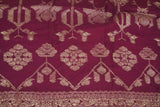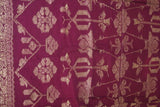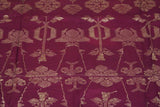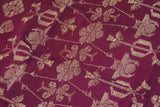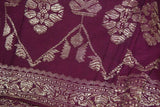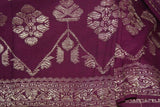Old Superb Ceremonial Balinese hand woven textile Antique Burgundy Ceremonial Songket Brocade damask Embroidery with Sacred Lotus Motif with Metallic Gold Threads 65" x 42" (SG42) Collected in Klunkung Regency, Bali & belonging to Nobility royalty
TEXTILES OF THE PAST
Museum quality, unique authentic collector Songket Brocade dowry textile. Once belonged to Balinese royalty, used mostly for ceremonial purposes because of their worth. Burgundy embroidery with lotus motifs and metallic gold threads. Handwoven with handspun silk and cotton blend.
SIZE: 65" x 42".
ITEM: SG42
COLLECTED AND IN KLUNKGUNG
OVER 80 YEARS OLD
Great condition for this older masterpiece, no holes no tears.
It was passed on from one generation to the next and at one time, cut in 1/2 and resewn, the seam is seen in the middle.
All handmade from the hand spinning to the hand weaving to the hand embroidered needlework: minute time-consuming intricate and perfect embroidery motifs! Takes long months to achieve, sometimes years! Never 2 of those prized cloths are alike!
Songket is a fabric that belongs to the family of brocade textiles. It is hand woven in silk or cotton, and intricately patterned with gold or silver threads. The metallic threads stand out against the background cloth to create a shimmering effect. In the weaving process the metallic threads are inserted in between the silk or cotton weft (latitudinal) threads. The term songket comes from the Malay Indonesian word sungkit, which means "to hook". It has something to do with the method of songket making; to hook and pick a group of threads, and then slip the gold threads in it. The word menyongket means "to embroider with gold or silver threads".
Songket is a luxury product traditionally worn during ceremonial occasions as sarong, shoulder cloths or head ties. Tanjak or Songket headdresses were worn at the courts of the Malay Sultanates and nobility. Traditionally women and adolescent girls wove songket and traditionally-patterned textiles embodied a system of interpretable emblems to the few that were able to create them and wear them.
Few costumes in the world have the dignified elegance of the ceremonial costume of a noblewoman: the underskirt dragging on the ground in a train of silk and gold; the torso, bound from the hips to the armpits; first is a strong bulang, a strip of cloth covered by a sabuk, another strip of silk overlaid, and gold leaf and gold plugs through her ears.
All our collector and rare items come with pages and pages of research about provenance, and with history of the tribes and photos as well, depending on item and whenever possible. When shipping internationally, we group ship multiple purchases to save you money, and find the best rates available. If you have any questions or want to see research conducted on this piece and photos of tribes, tell us.














